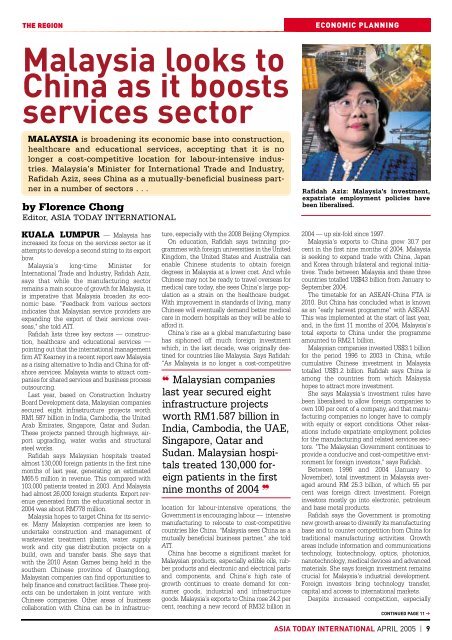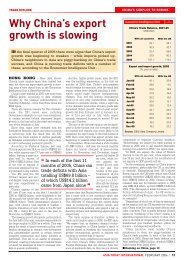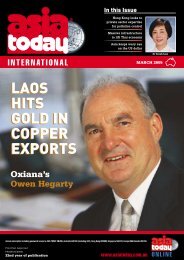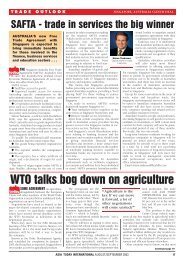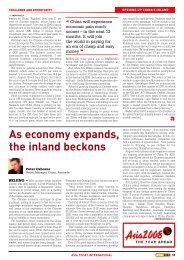➔ FROM PAGE 8TSUNAMI FUNDING LAGSlabour laws, judicial systems and lawenforcement, and to improve the climate toattract investment into infrastructure development.Business also wants theGovernment to review and revise the lawon autonomy, which devolves power tolocal governments."We are waiting and pushing thePresident to move more quickly on reformsto our taxation system, the laws on labourand regional autonomy," says Hidayat.Business leaders also spoke of another"crucial problem" — the public sector. Theyfeel changes pursued by the central governmentare not being implemented by thebureaucracy. "Indonesian bureaucracy isstill living out the old paradigm." he says."We keep reminding the Government tokeep to its reform targets because we simplycannot wait any more."They point out that this Government isthe first popularly-elected in Indonesia, andthat it has the next five years to implementpolicies that can change the course ofIndonesia's history. If the Government doesnot grasp this opportunity, they fret thatIndonesia will be doomed to stagnation.Chris Kanter, a KADIN Vice President, saysthis is a pro-business Government supportedby the people. So, for the first time, thecountry is united in the direction in whichit should move forward.❝ If the Governmentdoes not grasp thisopportunity, theyfret that Indonesiawill be doomed tostagnation.❞Kanter says the previous Governmentsubmitted a draft to reform Indonesia's taxationsystem, but this was not implemented."Business did not agree to the plan.Now we have a new Government and thePresident gave us the plan to review. Whatwe are looking for is equality. The currenttax law is one-sided. The Director Generalof Taxation is the person to bring taxinfringement charges and he is also the persondoing the investigation. He judges ontax evasion and he also handles appealsagainst the Department's decision. We arelooking for a separation of power."Kanter says business believes it would beuseful to have an amnesty period to allowpeople the opportunity to pay back taxes.The Government is reviewing its options onhow it can increase tax revenue.John Prasetio says reform of the publicservice will lead to cost saving for peopledoing business. Anti-corruption measuresare also crucial to creating a better businessenvironment in Indonesia. "MostIndonesians support the move for the privatesector to work with the Government tofight corruption," he says.INDONESIA’S President, SusiloBambang Yudhoyono, came to Australia to personallythank the Howard Government and theAustralian people for their generosity and assistancein recent crises.Australia offered the largest single aid packageof AUD1 billion — AUD500 million in grantsand AUD500 in concessional loans — for Aceh,when it was struck by the December tsunami.Then came additional aid and assistance whenSumatra was hit by an earthquake.Australia is one of three donors to have putmoney on the table. "Australia has offered usvery good terms — 10 years‚ grace on interestpayment and another 40 years to repay theloan," Indonesia's Co-ordinating Minister forEconomic Affairs, Aburizal Bakrie, told ATIwhen he visited Australia in March."The loan is for Indonesia reconstruction andnot just for Aceh," Bakrie said, During his visitfor a bi-lateral Joint Ministerial Meeting,Australia and Indonesia agreed to formthe Australia Indonesia Partnership forReconstruction and Development (AIPRD),chaired by leaders of both countries. "The forumwill decide how much will actually go to Aceh,"Bakrie says.He was especially pleased that Australia hasagreed to use some of the funding for training."It is our wish that donor countries agree to letus use the money on training. One-third of thelecturers from the University of Aceh passedaway in the tsunami." (The World Bank'sCountry Manager for Indonesia, Andrew Steer,told ATI in January that half of the province'scivil servants were killed).Bakrie says the Japanese have delivered, witha grant of US$147 million. "We have signed aUS$300 million grant with the <strong>Asia</strong>nDevelopment Bank. They are also offering concessionaryloans of about $250 million. This is ontop of what the ADB will contribute under thearrangement of the Consultative Group onIndonesia." Bakrie says the CGI has pledgedUS$1.7 billion for 2005, which will be dispersedthis year.As for other countries, he is awaiting confirmationof their aid offers. "All I know is what Iread in the newspapers. I read that citizens inthe EU have pledged 1.4 billion euro and the ECwill offer 300 million euro. I also read in thepapers that US citizens have raised US$800 millionfor tsunami victims."THE REGIONAustralia, Japan deliver — butother aid pledges still missing❝ The Bush Administrationhas pledgedUS$950 million. I readthat the money is forall the tsunami-affectedcountries. I do notknow how muchIndonesia will get.❞Aburizal Bukrie:What will we get?The Bush Administration has pledged a totalof US$950 million, including US$124 million forthe three months of relief effort. "I read that themoney is for all the tsunami-affected countries.I do not how much Indonesia will get."Now that Indonesia has published its 12-volumereconstruction plan, it hopes that donorcountries will start to release funds.Reconstruction of Aceh has formally begun, andJakarta faces a tough job in accommodating thewishes of donor countries. Most, understandably,seek to undertake highly-visible projects."Our approach will be — if several donorcountries want to rebuild a particular project,we will have to divide it. For example, at leastfour countries want to rebuild the main highway.We might have to cut it into four sectors sothat each of the four countries will have a pieceof it." The 285-km highway on the Indian Oceanhas been seriously damaged, with sectionswashed away by waves.The Government has listed the highway as apriority, along with hospitals, schools andmosques. "There are no shops, no businesses inAceh, and we have to rebuild all of that. Shopshave been washed away. Water treatmentplants, electricity and other infrastructure weredamaged," says Bakrie.When foreign aid finally arrives, he says theGovernment will channel the money in fourdirections. Australia is the only country that willmanage its aid on a bilateral basis. Other donorcountries would like to go through multi-donortrust funds, managed by the World Bank. The<strong>Asia</strong>n Development Bank will manage its ownfunds, and some countries are willing to putmoney into the Indonesian budget.The non-government organisations (NGOs)have received a lot of money which is not coordinated.Says Bakrie : “We hope that for thereconstruction and rehabilitation, the NGOswill accept the Government's co-ordinated planand work with us. I do not want to see too manyhouses built in one region when nobodywants to live there."8 | ASIA TODAY INTERNATIONAL APRIL 2005
THE REGIONECONOMIC PLANNINGMalaysia looks toChina as it boostsservices sectorMALAYSIA is broadening its economic base into construction,healthcare and educational services, accepting that it is nolonger a cost-competitive location for labour-intensive industries.Malaysia’s Minister for <strong>International</strong> Trade and Industry,Rafidah Aziz, sees China as a mutually-beneficial business partnerin a number of sectors . . .by Florence ChongEditor, ASIA TODAY INTERNATIONALRafidah Aziz: Malaysia’s investment,expatriate employment policies havebeen liberalised.KUALA LUMPUR — Malaysia hasincreased its focus on the services sector as itattempts to develop a second string to its exportbow.Malaysia's long-time Minister for<strong>International</strong> Trade and Industry, Rafidah Aziz,says that while the manufacturing sectorremains a main source of growth for Malaysia, itis imperative that Malaysia broaden its economicbase. "Feedback from various sectorsindicates that Malaysian service providers areexpanding the export of their services overseas,"she told ATI.Rafidah lists three key sectors — construction,healthcare and educational services —pointing out that the international managementfirm AT Kearney in a recent report saw Malaysiaas a rising alternative to India and China for offshoreservices. Malaysia wants to attract companiesfor shared services and business processoutsourcing.Last year, based on Construction IndustryBoard Development data, Malaysian companiessecured eight infrastructure projects worthRM1.587 billion in India, Cambodia, the UnitedArab Emirates, Singapore, Qatar and Sudan.These projects panned through highways, airportupgrading, water works and structuralsteel works.Rafidah says Malaysian hospitals treatedalmost 130,000 foreign patients in the first ninemonths of last year, generating an estimatedM65.5 million in revenue. This compared with103,000 patients treated in 2003. And Malaysiahad almost 26,000 foreign students. Export revenuegenerated from the educational sector in2004 was about RM778 million.Malaysia hopes to target China for its services.Many Malaysian companies are keen toundertake construction and management ofwastewater treatment plants, water supplywork and city gas distribution projects on abuild, own and transfer basis. She says thatwith the 2010 <strong>Asia</strong>n Games being held in thesouthern Chinese province of Guangdong,Malaysian companies can find opportunities tohelp finance and construct facilities. These projectscan be undertaken in joint venture withChinese companies. Other areas of businesscollaboration with China can be in infrastruc-ture, especially with the 2008 Beijing Olympics.On education, Rafidah says twinning programmeswith foreign universities in the UnitedKingdom, the United States and Australia canenable Chinese students to obtain foreigndegrees in Malaysia at a lower cost. And whileChinese may not be ready to travel overseas formedical care today, she sees China's large populationas a strain on the healthcare budget.With improvement in standards of living, manyChinese will eventually demand better medicalcare in modern hospitals as they will be able toafford it.China's rise as a global manufacturing basehas siphoned off much foreign investmentwhich, in the last decade, was originally destinedfor countries like Malaysia. Says Rafidah:“As Malaysia is no longer a cost-competitive❝ Malaysian companieslast year secured eightinfrastructure projectsworth RM1.587 billion inIndia, Cambodia, the UAE,Singapore, Qatar andSudan. Malaysian hospitalstreated 130,000 foreignpatients in the firstnine months of 2004 ❞location for labour-intensive operations, theGovernment is encouraging labour — intensivemanufacturing to relocate to cost-competitivecountries like China. “Malaysia sees China as amutually beneficial business partner," she toldATI.China has become a significant market forMalaysian products, especially edible oils, rubberproducts and electronic and electrical partsand components, and China's high rate ofgrowth continues to create demand for consumergoods, industrial and infrastructuregoods. Malaysia’s exports to China rose 24.2 percent, reaching a new record of RM32 billion in2004 — up six-fold since 1997.Malaysia's exports to China grew 30.7 percent in the first nine months of 2004. Malaysiais seeking to expand trade with China, Japanand Korea through bilateral and regional initiatives.Trade between Malaysia and these threecountries totalled US$43 billion from January toSeptember 2004.The timetable for an ASEAN-China FTA is2010. But China has concluded what is knownas an "early harvest programme" with ASEAN.This was implemented at the start of last year,and, in the first 11 months of 2004, Malaysia'stotal exports to China under the programmeamounted to RM2.1 billion.Malaysian companies invested US$3.1 billionfor the period 1996 to 2003 in China, whilecumulative Chinese investment in Malaysiatotalled US$1.2 billion. Rafidah says China isamong the countries from which Malaysiahopes to attract more investment.She says Malaysia's investment rules havebeen liberalised to allow foreign companies toown 100 per cent of a company, and that manufacturingcompanies no longer have to complywith equity or export conditions. Other relaxationsinclude expatriate employment policiesfor the manufacturing and related services sectors."The Malaysian Government continues toprovide a conducive and cost-competitive environmentfor foreign investors," says Rafidah.Between 1996 and 2004 (January toNovember), total investment in Malaysia averagedaround RM 25.3 billion, of which 55 percent was foreign direct investment. Foreigninvestors mostly go into electronic, petroleumand base metal products.Rafidah says the Government is promotingnew growth areas to diversify its manufacturingbase and to counter competition from China fortraditional manufacturing activities. Growthareas include information and communicationstechnology, biotechnology, optics, photonics,nanotechnology, medical devices and advancedmaterials. She says foreign investment remainscrucial for Malaysia's industrial development.Foreign investors bring technology transfer,capital and access to international markets.Despite increased competition, especiallyCONTINUED PAGE 11 ➔ASIA TODAY INTERNATIONAL APRIL 2005 | 9


